Uber Bundle
Who Really Calls the Shots at Uber?
Unraveling the mystery of Uber SWOT Analysis is more than just a curiosity; it's key to understanding the company's future. Knowing the Uber parent company and its key stakeholders is crucial for anyone looking to invest, partner, or simply understand this global mobility giant. The Uber ownership structure has evolved significantly since its inception, shaping its strategy and influencing its market performance.
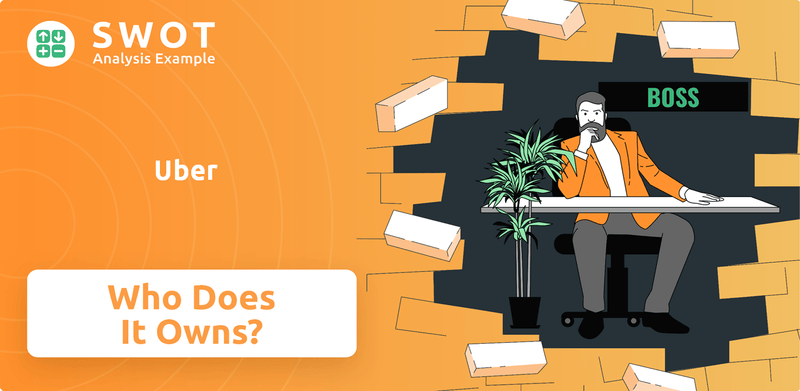
From its humble beginnings to its current status as a publicly traded entity, the journey of Uber's ownership is a compelling story of venture capital, strategic partnerships, and public market dynamics. Understanding who the Uber shareholders are and the influence of Uber executives provides insights into the company's strategic decisions, including its expansion into new markets and diversification of services. This exploration of Uber's ownership structure explained will help you understand how to invest in Uber and navigate the complexities of its corporate governance.
Who Founded Uber?
The ride-sharing giant, initially known as UberCab, was brought to life in March 2009. The company was founded by Garrett Camp and Travis Kalanick, who conceived the idea after facing difficulties hailing a cab in Paris. The early days involved developing a mobile app prototype to streamline transportation.
Early funding and ownership were crucial in shaping the company's trajectory. Initial investments and the allocation of shares among the founders and early backers set the stage for Uber's future growth. The evolution of the company's ownership structure reflects its journey from a startup to a publicly traded corporation.
Understanding the founders, early investors, and the shifts in ownership provides valuable insights into the development and the current structure of the company. This includes the roles of key figures, the initial funding rounds, and the changes in governance over time.
Uber was founded in March 2009 by Garrett Camp and Travis Kalanick. The idea came from their experience in Paris in 2008. Camp, with help from Oscar Salazar and Conrad Whelan, built the app prototype, while Kalanick acted as an advisor.
The company secured a seed funding of $200,000 in 2009. An angel round in 2010 raised $1.25 million, led by First Round Capital. Early investors included Shawn Fanning and Jeff Bezos.
Specific initial equity splits are not fully public. At the time of the IPO, Garrett Camp held a 4.6% stake, while Travis Kalanick owned 6.7%. Early agreements likely included vesting schedules to retain talent.
Ryan Graves was awarded between 5% and 10% of the company initially. In October 2017, Uber removed its dual-class share structure. This was supported by Dara Khosrowshahi and investors like SoftBank.
Early backers included First Round Capital and angel investors like Shawn Fanning and Jeff Bezos. Uber's Marketing Strategy of Uber has been key to its growth.
As of early 2024, Uber's market capitalization is approximately $150 billion. This reflects the company's growth and the impact of its strategic decisions.
The evolution of Uber's ownership structure, from its founders to its current shareholders, highlights the complexities of corporate governance and the impact of early decisions. Understanding the roles of key figures, the initial funding rounds, and the shifts in ownership over time is important. Uber's journey reflects a transition from a startup to a publicly traded company, with changes in governance and the influence of major stakeholders impacting its trajectory. The company's current market cap, reflecting its growth and strategic decisions, is approximately $150 billion as of early 2024. The company's ownership structure is influenced by its initial public offering (IPO) and the involvement of various investors. The current CEO is Dara Khosrowshahi, who has been instrumental in shaping the company's direction.
Uber SWOT Analysis
- Complete SWOT Breakdown
- Fully Customizable
- Editable in Excel & Word
- Professional Formatting
- Investor-Ready Format
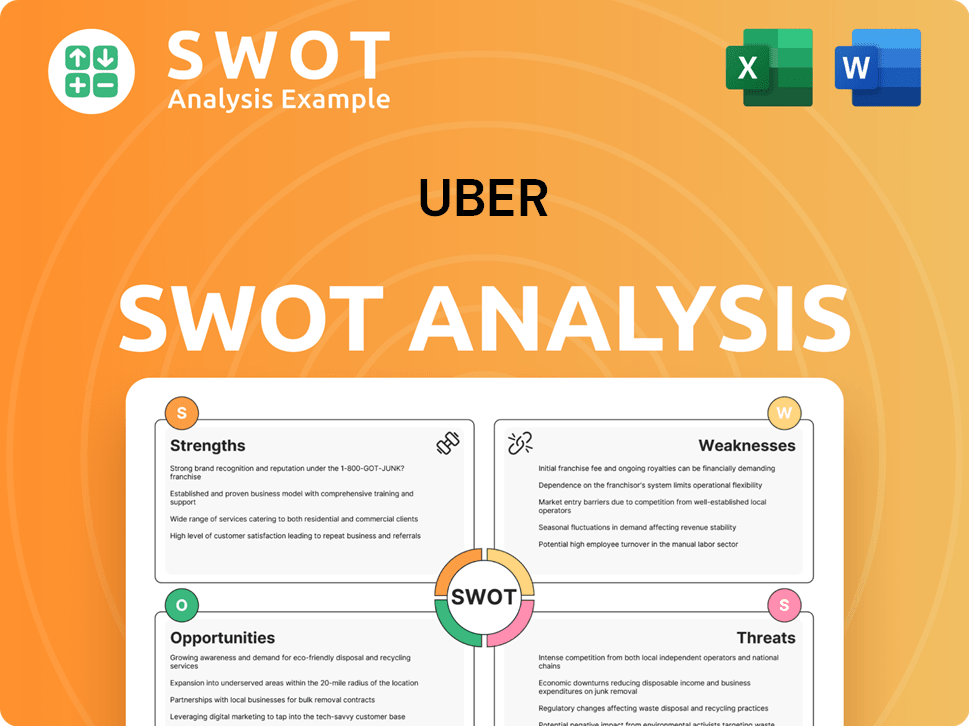
How Has Uber’s Ownership Changed Over Time?
The ownership structure of the ride-hailing giant, has undergone significant changes since its inception. Early funding rounds, including a Series A in 2011 and a Series F by 2015, shaped its initial ownership. The company's valuation soared, reaching $51 billion by 2015. This period was marked by substantial capital infusions, including debt financing like the $1.6 billion from Goldman Sachs, setting the stage for its future as a publicly traded company.
The transition to a public entity occurred on May 10, 2019, with its initial public offering (IPO). As of June 11, 2025, its market capitalization is approximately $181.06 billion. The shift to public markets and the evolution of its ownership structure reflect its growth and integration into major financial markets. Understanding the evolution of its ownership is key to understanding its current operational and strategic direction.
| Event | Date | Impact |
|---|---|---|
| Series A Funding Round | Early 2011 | Secured initial investment for expansion. |
| Series F Funding Round | 2015 | Valued the company at $51 billion. |
| IPO | May 10, 2019 | Transitioned to a public company, opening ownership to a wider investor base. |
The current ownership is largely dominated by institutional investors. As of December 31, 2024, these investors held 81.71% of the shares, and by June 2024, this increased to 86.71%. Mutual fund holdings also saw an increase, reaching 63.98% by June 2024. This shift towards institutional ownership highlights the company's maturity and its integration into the broader financial landscape. The major shareholders include Vanguard Group Inc., BlackRock, Inc., and Capital Research Global Investors, among others. This concentration of ownership gives these major stakeholders considerable influence over the company's strategic decisions and governance.
The ownership structure of the company has evolved significantly from early funding rounds to its IPO and beyond.
- Institutional investors hold a large majority of the shares.
- Major stakeholders include Vanguard, BlackRock, and Capital Research.
- The company's market capitalization is substantial, reflecting its market position.
- Understanding the ownership structure is crucial for investors and stakeholders. Learn more about the Competitors Landscape of Uber.
Uber PESTLE Analysis
- Covers All 6 PESTLE Categories
- No Research Needed – Save Hours of Work
- Built by Experts, Trusted by Consultants
- Instant Download, Ready to Use
- 100% Editable, Fully Customizable
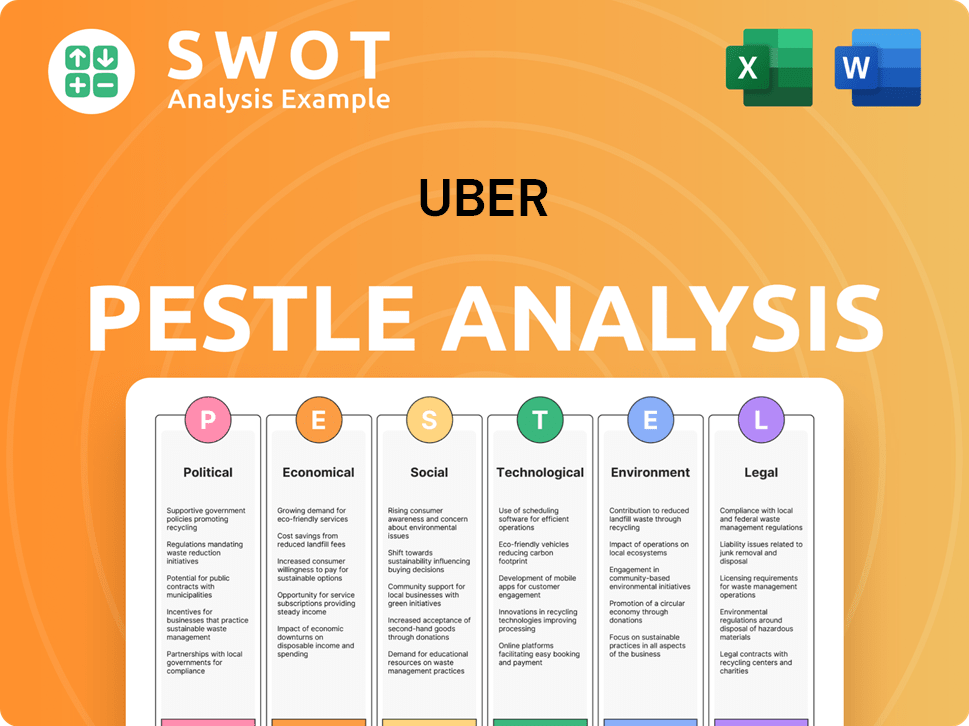
Who Sits on Uber’s Board?
The current board of directors of Uber Technologies, Inc. is pivotal in steering the company's direction and ensuring sound governance. The board includes the CEO, Dara Khosrowshahi, who also serves as a director. Ronald Sugar is the Chairman of the board. The board's composition typically includes representatives from major shareholders, founders, and independent directors. Understanding the structure of Uber ownership, including the roles of Uber executives and Uber investors, is crucial for anyone looking into the Uber company structure.
The board's structure is designed to balance the interests of various stakeholders, ensuring that strategic decisions are made with careful consideration of both short-term performance and long-term sustainability. This approach helps maintain a stable and effective leadership framework, which is essential for a publicly traded company like Uber. The board oversees key aspects of the business, including financial performance, risk management, and compliance, making it a central element of Uber's corporate governance.
| Board Member | Position | Key Role |
|---|---|---|
| Dara Khosrowshahi | CEO & Director | Oversees overall company strategy and operations. |
| Ronald Sugar | Chairman of the Board | Leads the board and ensures effective governance. |
| Independent Directors | Various | Provide independent oversight and bring diverse expertise. |
Uber's voting structure transitioned to a 'one-share, one-vote' policy in 2017, a significant move that eliminated special voting rights previously held by certain classes of shares. This shift towards a more equitable voting system was supported by the Council of Institutional Investors (CII), which advocates for shareholder accountability. This change is highlighted in Uber's IPO prospectus, underscoring its commitment to strong corporate governance. This 'one-share, one-vote' structure ensures that economic rights are directly proportional to voting rights, making it easier to understand Uber's ownership structure explained. For more information on Uber's strategic direction, you can read about the Growth Strategy of Uber.
Uber's board of directors plays a crucial role in overseeing the company's strategic direction and ensuring good governance. The 'one-share, one-vote' policy ensures a fair voting structure. Major institutional shareholders, like Vanguard and BlackRock, hold substantial voting power.
- The board includes the CEO, Chairman, and independent directors.
- Uber's shift to a single class of shares improved shareholder accountability.
- Institutional investors have significant influence due to their large holdings.
- Understanding who are Uber's major stakeholders is key to understanding the company.
Uber Business Model Canvas
- Complete 9-Block Business Model Canvas
- Effortlessly Communicate Your Business Strategy
- Investor-Ready BMC Format
- 100% Editable and Customizable
- Clear and Structured Layout
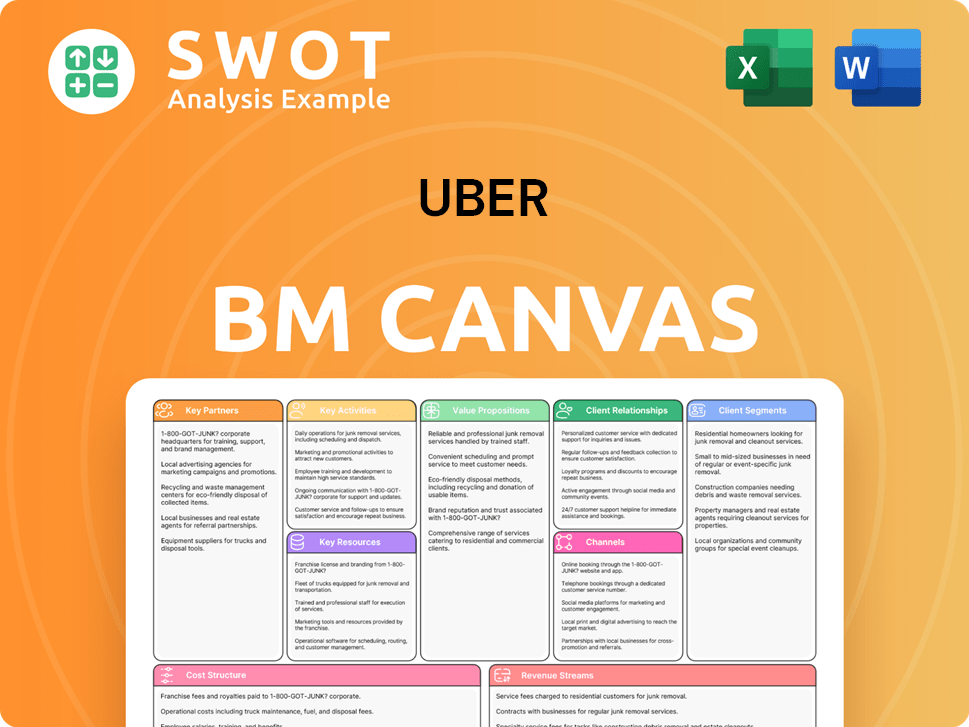
What Recent Changes Have Shaped Uber’s Ownership Landscape?
Over the past few years, the Uber ownership landscape has evolved, with a notable shift towards institutional investors. As of December 31, 2024, institutional investors held around 81.71% of the company's shares. By June 2024, this had increased to 86.71%. This trend highlights the growing influence of institutional investors in shaping the company's direction and strategic decisions.
In February 2025, the Uber parent company announced a $7 billion share buyback program, reflecting confidence in its financial health. This move followed the achievement of its first full year of GAAP operating profit in 2023, reporting $1.1 billion. The company's financial performance in Q1 2025 was robust, with revenue reaching $11.5 billion, up 14% year-over-year (17% in constant currency), and Adjusted EBITDA growing 35% year-over-year to $1.87 billion. Free cash flow for Q1 2025 was $2.25 billion.
The leadership under CEO Dara Khosrowshahi, who has been in the role since 2017, has been praised for steering the company towards profitability. Founder Travis Kalanick's departure as CEO in 2017 and the subsequent removal of his super-voting shares solidified a 'one-share, one-vote' structure. The company continues to expand its service offerings, including partnerships for electric vehicle leasing and autonomous vehicle technology, and has announced partnerships with Waymo and OpenTable in 2025.
| Metric | Q1 2025 | Year-over-Year Change |
|---|---|---|
| Revenue | $11.5 billion | +14% (17% in constant currency) |
| Adjusted EBITDA | $1.87 billion | +35% |
| Free Cash Flow | $2.25 billion | N/A |
Institutional investors held approximately 81.71% of shares as of December 31, 2024, increasing to 86.71% by June 2024. This indicates a significant shift in Uber ownership towards institutional investors, impacting the company's strategic direction.
Q1 2025 showed strong financial results, with revenue at $11.5 billion and Adjusted EBITDA at $1.87 billion. The company's focus on profitability is evident, with a share buyback program of $7 billion announced in February 2025 and a free cash flow of $2.25 billion.
Dara Khosrowshahi continues as CEO, driving the company's focus on sustainable growth. Uber executives are targeting a +30% annual EPS growth. The company is expanding services, including partnerships in electric and autonomous vehicles, showing a forward-thinking approach.
The ride-hailing and delivery sectors are emphasizing profitability. Uber investors can see the company exceeding its 2024 commitments for gross bookings growth and adjusted EBITDA growth. The company is also focusing on expansion and strategic partnerships.
Uber Porter's Five Forces Analysis
- Covers All 5 Competitive Forces in Detail
- Structured for Consultants, Students, and Founders
- 100% Editable in Microsoft Word & Excel
- Instant Digital Download – Use Immediately
- Compatible with Mac & PC – Fully Unlocked
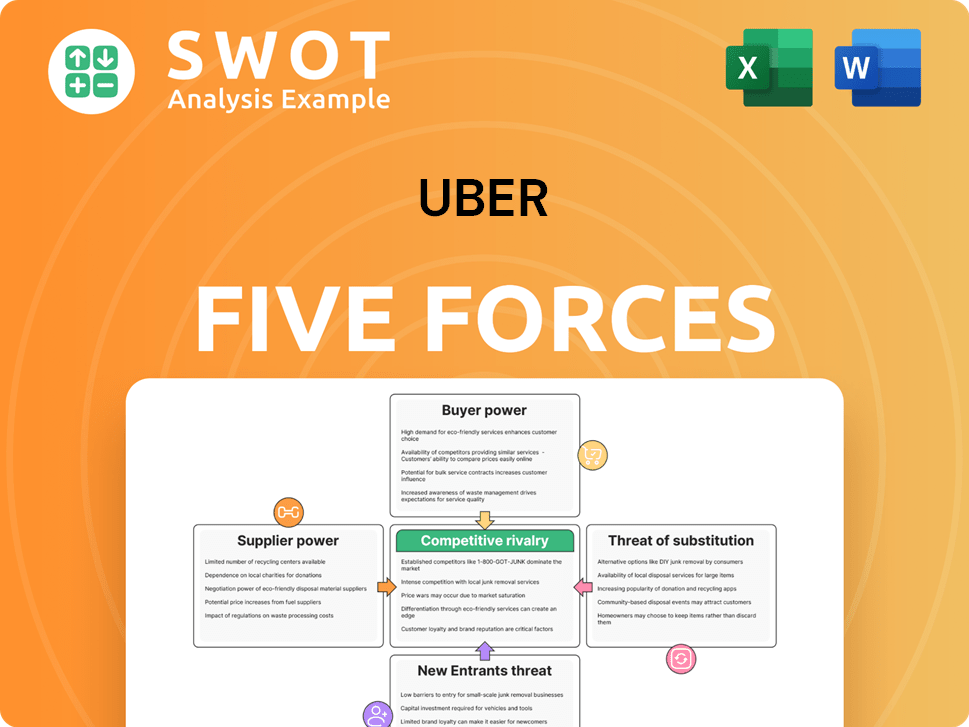
Related Blogs
- What are Mission Vision & Core Values of Uber Company?
- What is Competitive Landscape of Uber Company?
- What is Growth Strategy and Future Prospects of Uber Company?
- How Does Uber Company Work?
- What is Sales and Marketing Strategy of Uber Company?
- What is Brief History of Uber Company?
- What is Customer Demographics and Target Market of Uber Company?
Disclaimer
All information, articles, and product details provided on this website are for general informational and educational purposes only. We do not claim any ownership over, nor do we intend to infringe upon, any trademarks, copyrights, logos, brand names, or other intellectual property mentioned or depicted on this site. Such intellectual property remains the property of its respective owners, and any references here are made solely for identification or informational purposes, without implying any affiliation, endorsement, or partnership.
We make no representations or warranties, express or implied, regarding the accuracy, completeness, or suitability of any content or products presented. Nothing on this website should be construed as legal, tax, investment, financial, medical, or other professional advice. In addition, no part of this site—including articles or product references—constitutes a solicitation, recommendation, endorsement, advertisement, or offer to buy or sell any securities, franchises, or other financial instruments, particularly in jurisdictions where such activity would be unlawful.
All content is of a general nature and may not address the specific circumstances of any individual or entity. It is not a substitute for professional advice or services. Any actions you take based on the information provided here are strictly at your own risk. You accept full responsibility for any decisions or outcomes arising from your use of this website and agree to release us from any liability in connection with your use of, or reliance upon, the content or products found herein.